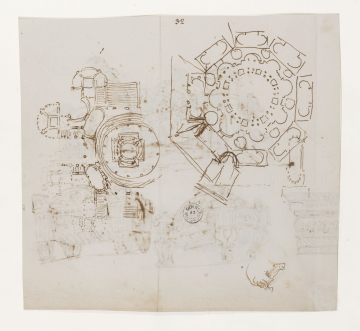Inscribed
Inscribed in ink on drawing 32verso inscribed in chalk in a contemporary hand, part of 10 lines of a list of payments in columns To Salle / To Lazaro / Left / To Do Hou / Saturday 16 / To Rus / after / To Spar / the / Alt /.
Signed and dated
- Undated, probably 1755 - 56.
Medium and dimensions
Pen204 x 223, vertical foldline
Hand
Robert Adam
Verso
Capriccio in grey wash and pen showing a ruined, barrel-vaulted hall with niches beside a square tower in a wooded setting. Below this: two elaborately carved funerary urns, one oval and one square, each with four short legs; also, at far left, a small detail of cornice and frieze. The mausoleum theme on the recto - San Costanza was the Mausoleum of Constantina - perhaps explains the drawing of funerary urns, of which there are other exercises in Adam vol.9/42 and 55/117. The capriccio is similar in subject and style to that in Adam vol.9/30. The inscription is probably in Robert Adam's hand and refers to activities on a 'Saturday 16'.
Watermark
names
Notes
The plan of the octagonal pavilion was possible derived from the Baptistery at San Giovanni Laterano in Rome, Italy or, for the coupled columns, from San Costanza in Rome or San Vitale at Ravenna. Giorgio Vasari the Younger provided a rich collection of these forms in his Piante di Chiese of 1598; in the Roman section of Adam volume 57 there are views of Santa Costanza (see Adam vol.57/ ). The plan of the circular building has a similar antique source in the Maritime Theatre at Tivoli, Italy or in classical mausoleum plans. The mausoleum theme - San Costanza was the Mausoleum of Constantina - perhaps explains the drawing on the verso of funerary urns.
Literature
verso rep. J. Fleming, Robert Adam and His Circle in Edinburgh & Rome, London, 1962, pl.42.
Level
Drawing
Digitisation of the Drawings Collection has been made possible through the generosity of the Leon Levy Foundation
Sir John Soane's collection includes some 30,000 architectural,
design and topographical drawings which is a very important resource for
scholars worldwide. His was the first architect’s collection to attempt to
preserve the best in design for the architectural profession in the future, and
it did so by assembling as exemplars surviving drawings by great Renaissance
masters and by the leading architects in Britain in the 17th and 18th centuries
and his near contemporaries such as Sir William Chambers, Robert Adam and
George Dance the Younger. These drawings sit side by side with 9,000 drawings
in Soane’s own hand or those of the pupils in his office, covering his early
work as a student, his time in Italy and the drawings produced in the course of
his architectural practice from 1780 until the 1830s.
Browse (via the vertical menu to the left) and search results for Drawings include a mixture of
Concise catalogue records – drawn from an outline list of the collection – and
fuller records where drawings have been catalogued in more detail (an ongoing
process).


